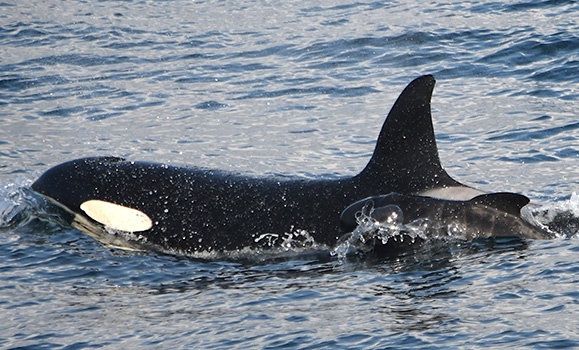The gleaming black killer whale can be seen cutting through the surface of the water, its distinctive white markings and triangular dorsal fin popping up as it cruised the coastline of West Iceland with a couple of other orcas a year and a half ago.
There was a female known to researchers as Dragonfly, a male named Zale and another female called SûÎdiäs, with the trio often spotted in the area over the years as they fed on Atlantic herring.
Observers on board a whale-watching vessel who were monitoring the whales near SnûÎfellsnes noticed something peculiar about SûÎdiäs. As she passed by, they saw a small calf tucked in close to SûÎdiäs and swimming alongside her. They soon realized that the newborn was not an orca and therefore not her own offspring. Instead, the researchers identified it as a long-finned pilot whale calf that appeared to be emaciated, but being cared for by the killer whale as it traveled along in her slipstream.
For 21 minutes on that day in August 2021, they watched the adult killer whale and pilot whale calf swim together in what is now thought to be the first recorded case of an orca caring for the offspring of another species.
"Killer whales have never been seen caring for the offspring of another species, so this in itself is extremely interesting," says Elizabeth Zwamborn, a PhD candidate in the Whitehead Lab at Åô¥Æóôꪤüýò¢ˆ§ÝøÝýË, who co-authored a new paper in the Canadian Journal of Zoology that outlines the interaction.
"Killer whales and pilot whales have similar mother-calf relationships and are closer in size than other species, which makes a pilot whale a good substitute for a killer whale calf."
Recommended reading:ä»Åô¥Æóôꪤüýò¢ˆ§ÝøÝýËãs push to put the ocean at the centre of the global climate conversation
Calf-napped, orphaned, adopted?
The researchers, from the West Iceland Nature Research Centre and Orca Guardians Iceland, suggest that it is possible the killer whale may have taken the pilot whale calf and been attempting to adopt it since she has never been documented with a calf of her own.
In effect, the young pilot whale may have been calf-napped, was orphaned or left behind.
Zwamborn says the interaction may help explain the complex behaviour of the two species when they encounter each other. There have been many accounts of pilot whales chasing killer whales off Iceland, but the true reasons for this remain a mystery. If some killer whales are calf-napping from them, it gives the pilot whales a good motive to chase off killer whales when the two species are in the same area.
"This particular killer whale had never been seen with a calf over the course of the study from 2011 to 2022, so it is possible that she canãt have calves or is unsuccessful with raising them," says Zwamborn. "This could give motive for her caring for the newborn pilot whale."
It's also possible they are competing for prey, even though it's believed they generally donãt feed on the same thing. Some have speculated pilot whales perceive the killer whales as a threat and chase them instead of running away.
There were no other pilot whales around at the time of the sighting.
Recommended reading:ä»Canada Foundation for Innovationä»invests $38.5M in Dalãled Ocean Tracking Network
Similar social structures
Orcas and long-finned pilot whales are thought to have similar social structures and mother-offspring relationships, making care-giving behavior between the two species a possibility. However, this is the first time such an association has been documented in the scientific literature.
The pair was seen only on that one occasion, and when SûÎdiäs was spotted again the following year the calf didn't appear to be with her.
The researchers also noted that the calf was in the so-called echelon position next to the adult, much like drafting in that it allows the young one to expend less energy while shielding them.
"As a form of aquatic infant-carrying behaviour, echelon swimming is considered one of the most energy-intensive forms of parental care after lactation and may impact energy budgets, predator evasion and foraging efficiency," the paper states.
"The observation of (SûÎdiäs) keeping the pilot whale calf in echelon position can also be seen as a form of ... nurturant behaviour."

